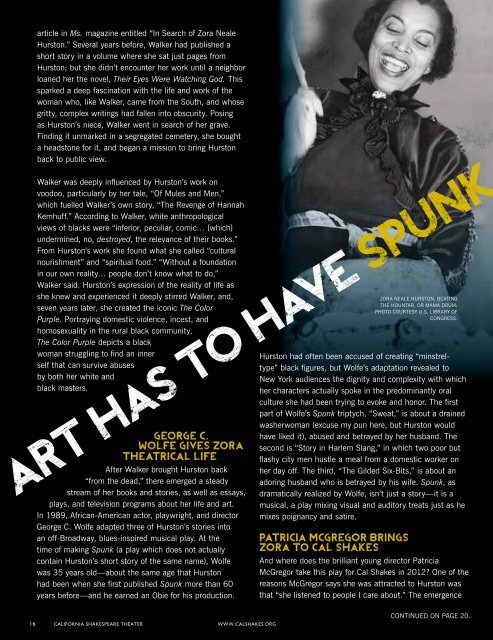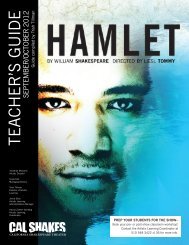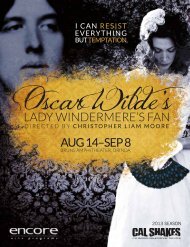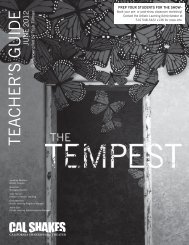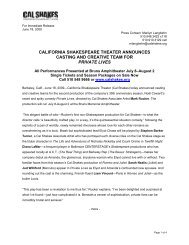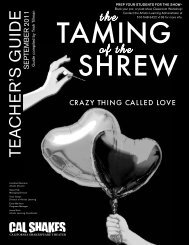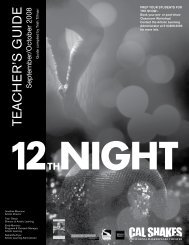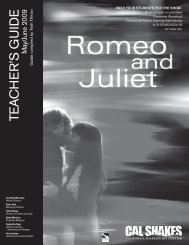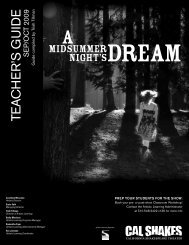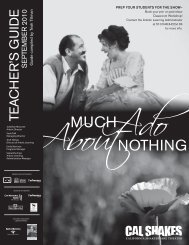Read Spunk Program - California Shakespeare Theater
Read Spunk Program - California Shakespeare Theater
Read Spunk Program - California Shakespeare Theater
You also want an ePaper? Increase the reach of your titles
YUMPU automatically turns print PDFs into web optimized ePapers that Google loves.
article in Ms. magazine entitled “In Search of Zora Neale<br />
Hurston.” Several years before, Walker had published a<br />
short story in a volume where she sat just pages from<br />
Hurston; but she didn’t encounter her work until a neighbor<br />
loaned her the novel, Their Eyes Were Watching God. This<br />
sparked a deep fascination with the life and work of the<br />
woman who, like Walker, came from the South, and whose<br />
gritty, complex writings had fallen into obscurity. Posing<br />
as Hurston’s niece, Walker went in search of her grave.<br />
Finding it unmarked in a segregated cemetery, she bought<br />
a headstone for it, and began a mission to bring Hurston<br />
back to public view.<br />
Walker was deeply infl uenced by Hurston’s work on<br />
voodoo, particularly by her tale, “Of Mules and Men,”<br />
which fuelled Walker’s own story, “The Revenge of Hannah<br />
Kemhuff.” According to Walker, white anthropological<br />
views of blacks were “inferior, peculiar, comic… [which]<br />
undermined, no, destroyed, the relevance of their books.”<br />
From Hurston’s work she found what she called “cultural<br />
nourishment” and “spiritual food.” “Without a foundation<br />
in our own reality… people don’t know what to do,”<br />
Walker said. Hurston’s expression of the reality of life as<br />
she knew and experienced it deeply stirred Walker, and,<br />
seven years later, she created the iconic The Color<br />
Purple. Portraying domestic violence, incest, and<br />
homosexuality in the rural black community,<br />
The Color Purple depicts a black<br />
woman struggling to fi nd an inner<br />
self that can survive abuses<br />
by both her white and<br />
black masters.<br />
GEORGE C.<br />
WOLFE GIVES ZORA<br />
THEATRICAL LIFE<br />
After Walker brought Hurston back<br />
“from the dead,” there emerged a steady<br />
stream of her books and stories, as well as essays,<br />
plays, and television programs about her life and art.<br />
In 1989, African-American actor, playwright, and director<br />
George C. Wolfe adapted three of Hurston’s stories into<br />
an off-Broadway, blues-inspired musical play. At the<br />
time of making <strong>Spunk</strong> (a play which does not actually<br />
contain Hurston’s short story of the same name), Wolfe<br />
was 35 years old—about the same age that Hurston<br />
had been when she fi rst published <strong>Spunk</strong> more than 60<br />
years before—and he earned an Obie for his production.<br />
16 california shakespeare theater www.calshakes.org<br />
Hurston had often been accused of creating “minstreltype”<br />
black fi gures, but Wolfe’s adaptation revealed to<br />
New York audiences the dignity and complexity with which<br />
her characters actually spoke in the predominantly oral<br />
culture she had been trying to evoke and honor. The fi rst<br />
part of Wolfe’s <strong>Spunk</strong> triptych, “Sweat,” is about a drained<br />
washerwoman (excuse my pun here, but Hurston would<br />
have liked it), abused and betrayed by her husband. The<br />
second is “Story in Harlem Slang,” in which two poor but<br />
fl ashy city men hustle a meal from a domestic worker on<br />
her day off. The third, “The Gilded Six-Bits,” is about an<br />
adoring husband who is betrayed by his wife. <strong>Spunk</strong>, as<br />
dramatically realized by Wolfe, isn’t just a story—it is a<br />
musical, a play mixing visual and auditory treats just as he<br />
mixes poignancy and satire.<br />
PATRICIA MCGREGOR BRINGS<br />
ZORA TO CAL SHAKES<br />
ZORA NEALE HURSTON, BEATING<br />
THE HOUNTAR, OR MAMA DRUM;<br />
PHOTO COURTESY U.S. LIBRARY OF<br />
CONGRESS.<br />
And where does the brilliant young director Patricia<br />
McGregor take this play for Cal Shakes in 2012? One of the<br />
reasons McGregor says she was attracted to Hurston was<br />
that “she listened to people I care about.” The emergence<br />
CONTINUED ON PAGE 20.


